Last updated on October 23rd, 2023 at 08:57 pm
Woodruff grows in many forests as ground cover and has been collected for centuries as a medicinal plant and flavoring. However, the plant can also be grown in your own garden in a suitable location.

Contents
The perfect location for the woodruff
The woodruff grows in the wild only in certain places in forests with preferably deciduous trees. Therefore, it can also form harvestable stands in the garden only if the location and care meet its needs. Choose a place for woodruff protected from direct sunlight under a tree or under shrubs. The soil should be as loose as possible and retain moisture well, but the site should not be prone to waterlogging. Woodruff is generally hardy, but in higher or exposed locations it should be covered with a layer of foliage in winter.
Growing woodruff in a pot
In principle, woodruff can be grown in pots like other herbs and medicinal plants. However, woodruff tends to dry out more quickly than herbs native to the south, such as rosemary and oregano. Therefore, a shady place is mandatory even when growing in a pot on the balcony or terrace. In addition, the planting container should be chosen large enough, because the woodruff spreads with its roots in the soil and thus also multiplies. It will be easier for you to keep the woodruff in the pot evenly moist if you first line the planter with some clay and then fill it with a permeable substrate.
Sowing and harvesting woodruff
In order to harvest woodruff for use in the kitchen in the spring before it flowers, you must sow the seeds the previous fall. Pay particular attention to the following factors:
- cover the seeds with soil to a depth of about 0.5 centimeters
- ensure even moisture during the germination phase
- do not sow the seeds too close to each other.
Tips & Tricks
If you already have stands of woodruff in your garden, you can also propagate it by dividing dug-up rhizomes.


